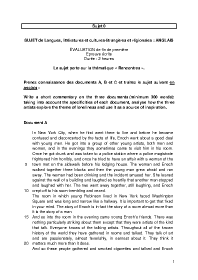A bildungsroman, sometimes also called a novel of education is a novel or story in which the reader follows the protagonist as he grows up, evolves and overcomes obstacles. The story mostly focusses on the way the protagonist moves from innocence to experience and how he or she learns to find his or her place in the world.
Classic examples of novels of apprenticeship include Great Expectations (1861) by Charles Dickens or Tom Sawyer (1876) by Mark Twain.
J. D. Salinger's novel The Catcher in the Rye (1951) depicts the anguish and the sense of alienation of a teenager. The main character, Holden Caulfield, after being expelled from his expensive prep school, wanders around New York. He strives to come to terms with what it means to grow up and be an adult. Most of the people he runs into or is acquainted with disappoint him. They are, in his own words, "phonies", in contrast with children whom he sees as innocent and needing protection from the world of adults.
More recently J.K. Rowling's The Harry Potter series (1997-2007) also fits into this genre. The series starts with Harry as a young boy and readers follow his adventures as he discovers who he truly is and what he can achieve.
In The Secret Diary of Adrian Mole aged 13 ¾, (1982) by Sue Townsend, the teenage narrator gives readers a hilarious account of his daily life and how difficult it is to grow up and make sense of the world around him.
There are many example of coming of age stories in cinema as well. For example, Sean Penn's film Into the Wild (2007), tells the true story of a young man who was eager to prove that he could survive on his own away from anyone else in "the wild". Dead Poets Society (1989) directed by P. Weir focusses on a group of teenage boys at an elite private school whose perspective on life and education is shaken up by their new English teacher.
One of the Beatles most famous songs She is leaving home (1967) is about a teenage girl running away from home "after living alone for so many years". The song manages to express the girl's feelings, her frustrations with her home life and her hopes for the future. It also captured the mood of the 60s when many teenagers felt at odds with their parents and what was expected of them.




